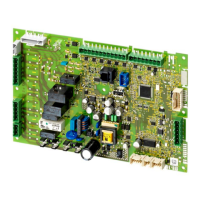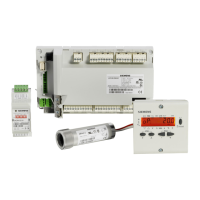336/617
Building Technologies Division User Manual LMS14… CC1U7471en
6 The settings in detail 28.01.2015
6.20 Stratification storage tank
The stratification storage tank is characterized by an external heat exchanger. To
charge the tank, (cold) water is fed from the lower section of the tank to an external
heat exchanger where it is heated. The hot water then returns to the upper section of
the storage tank. The benefit offered by this type of storage tank charging is that DHW
is available after a short period of time. In addition – depending on demand – only the
upper section of the storage tank will have to be charged. The lower section can be
charged by a solar plant, for example.
With stratification storage tank systems, either the pump in the primary circuit (DHW
charging pump (Q3) or, in the case of a diverting valve, the boiler pump (Q1)) or the
intermediate circuit pump can be a modulating pump.
Minimum and maximum limitation of the pump’s modulation range can be set via
parameters Pump speed min (5101) and Pump speed max (5102) respectively.
With stratification storage tanks, a distinction is made between 2 different types of DHW
charging:
1. Full charging.
2. Recharging.
The type of stratification storage tank charging depends primarily on parameter Type of
charging (5022).
The parameter offers the following setting choices:
Recharging:
The only type of stratification storage tank charging used is Recharging.
Full charging:
The only type of stratification storage tank charging used is Full charging.
Full charging legio:
When the Legionella function is due, the stratification storage tank is fully charged,
otherwise only recharged.
Full charg 1st time day:
The first charging cycle of the day is in the form of Full charging. If additional charging
cycles are required, Recharging is used.
Full charg 1st time legio:
The first charging cycle of the day and the Legionella function are in the form of Full
charging. If additional charging cycles are required, Recharging is used.
If the full charging criterion does not apply, Recharging is used.
Also, in the case of a stratification storage tank, the type of sensor used for controlling
the burner’s output during charging can be selected.
During storage tank charging (Recharging or Full charging), the control can be effected
either to the boiler flow temperature or the storage tank charging temperature. The
control to the storage tank charging temperature can take place either directly or
indirectly by adequately influencing the boiler temperature setpoint (setpoint
compensation).

